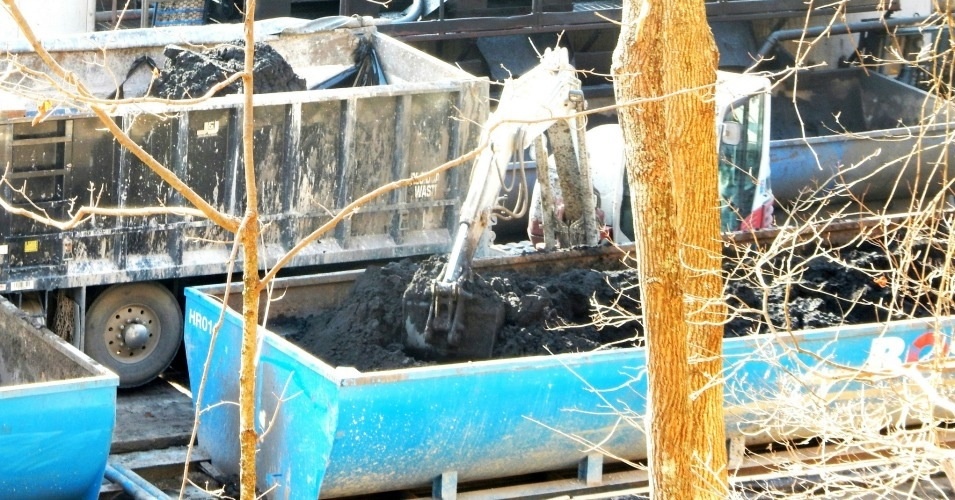Insufficient data and loose regulations worsen fracking's impact, studies find

Fracking waste at a drilling site in West Virginia. A new study finds existing regulations don't do enough to protect the public from exposure to fracking byproducts. (Photo by Earthworks/Bill Hughes.)
By Deirdre Fulton, Common Dreams
A slew of studies released last week, each examining different aspects of the fossil fuel extraction method known as "fracking," provide new evidence of problems with the practice.
The first, an investigation by the Natural Resources Defense Council and the FracTracker Alliance into oil and gas company violations, found that information about such transgressions is only publicly accessible in three states.
"Although 36 states have active oil and gas development, most state and federal oil and gas regulatory agencies publish little or no information regarding oil and gas companies’ compliance records," reads the report, Fracking's Most Wanted: Lifting the Veil on Oil and Gas Company Spills and Violations (pdf).
"Yet in states where data are available, we found significant violations both in number and severity," it continues. "These violations include a wide range of dangerous infractions like improper well casing, illegal air pollution, failure to conduct safety tests, improper construction or maintenance of waste pits, various spills, contamination of drinking water sources or other water bodies, and non-functional blow-out preventers."
Based on its findings, the report recommends the creation of a centralized and publicly accessible data hub on "all oil and gas enforcement activities, including citizen complaints, inspections, violation notices, and penalties issued, and incidents, including spills, leaks, blowouts, and worker injuries."
The NRDC also makes policy recommendations related to holding violators accountable and keeping "repeat offenders" out of local communities.
Hazardous Waste
In Wasting Away: Four states' failure to manage oil and gas waste in the Marcellus and Utica Shale (pdf), the environmental non-profit Earthworks examines how Pennsylvania, Ohio, West Virginia, and New York neither regulate oil and gas development wastes as hazardous, nor can they assure the public that they are protected from exposure to fracking byproducts.
"Thirty years ago the Environmental Protection Agency exempted oil and gas waste from federal classification as hazardous, not because the waste isn't hazardous, but because EPA determined state oversight was adequate," said report lead author and Earthworks' eastern program coordinator Nadia Steinzor.
However, she continued, "our analysis shows that states aren't keeping track of this waste or disposing of it properly. States must take realistic, concrete steps to better protect the public."
Activists in the affected areas expressed concern with the report's findings and called for stronger regulations.
"Whether it is wastewater or solids such as drill cuttings, we know that Marcellus shale waste is the elephant in the room that gas operators and regulators alike ignore," said Tracy Carluccio, deputy director of the Delaware Riverkeeper Network. "If the cost of treatment of this toxic material to standards protective of clean water was fully borne by the operators that are producing it, fracking for shale gas just wouldn't be economical. The only responsible course is for government to require that frack waste not pollute or degrade the environment, and apply our environmental laws to the fullest, no matter how it impacts companies' profits."
'Bad' Ozone
Lastly, a study published last Tuesday by researchers at the University of Wyoming found that emissions from wastewater treatment facilities at oil and gas drilling sites likely contributed to a string of "high-ozone events" in the winter of 2011 in Wyoming's Upper Green River Basin.
According to reporting by Environment & Energy Publishing, the team began studying the region's wintertime ozone levels and the mix of non-methane hydrocarbons in 2009.
They measured several high-ozone events in the winter of 2011, with ozone topping 85 parts per billion numerous times. The national standard for ozone is currently 75 ppb.
According to the EPA:
Ground level or "bad" ozone is not emitted directly into the air, but is created by chemical reactions between oxides of nitrogen (NOx) and volatile organic compounds (VOC) in the presence of sunlight. Emissions from industrial facilities and electric utilities, motor vehicle exhaust, gasoline vapors, and chemical solvents are some of the major sources of NOx and VOC. Breathing ozone can trigger a variety of health problems, particularly for children, the elderly, and people of all ages who have lung diseases such as asthma. Ground level ozone can also have harmful effects on sensitive vegetation and ecosystems.
"What we've done is hopefully just highlight that it's an important source that should be considered," said Robert Field, an atmospheric sciences professor at the University of Wyoming and lead author of the report.
Tags
Common Dreams
Common Dreams is a nonprofit independent newscenter that has been providing breaking news and views for the progressive community since 1997.
